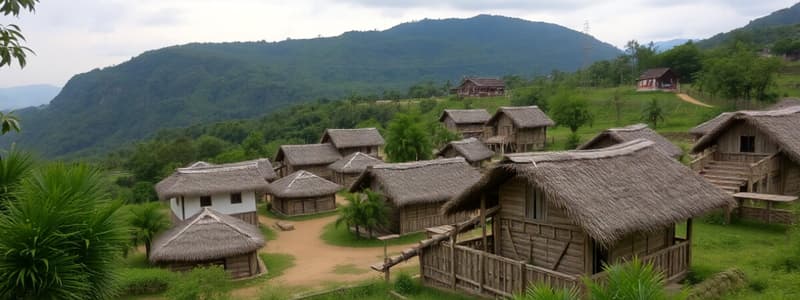Podcast
Questions and Answers
Prominent personalities include only men who contributed to the community.
Prominent personalities include only men who contributed to the community.
False (B)
Cultural institutions can only be public organizations.
Cultural institutions can only be public organizations.
False (B)
Civic heritage includes the history and development of the local government unit (LGU).
Civic heritage includes the history and development of the local government unit (LGU).
True (A)
All heritage items must meet significance in all fields to be documented.
All heritage items must meet significance in all fields to be documented.
The criteria for determining the significance of a cultural property align with UNESCO standards.
The criteria for determining the significance of a cultural property align with UNESCO standards.
The National Cultural Heritage Act of 2009 requires Local Government Units to conduct an inventory of cultural properties.
The National Cultural Heritage Act of 2009 requires Local Government Units to conduct an inventory of cultural properties.
Cultural mapping is exclusively focused on economic development.
Cultural mapping is exclusively focused on economic development.
Cultural mapping involves identifying and recording cultural resources and activities.
Cultural mapping involves identifying and recording cultural resources and activities.
A cultural map does not serve as a visualized database of a community's cultural resources.
A cultural map does not serve as a visualized database of a community's cultural resources.
Cultural resource mapping is a one-time process.
Cultural resource mapping is a one-time process.
The Manila Hotel has hosted many important events in Philippine history.
The Manila Hotel has hosted many important events in Philippine history.
The Philippines has no World Heritage Sites listed by UNESCO.
The Philippines has no World Heritage Sites listed by UNESCO.
The Manila Hotel is considered an ordinary commercial property.
The Manila Hotel is considered an ordinary commercial property.
Built heritage includes traditional dwellings and government buildings.
Built heritage includes traditional dwellings and government buildings.
Conservation of cultural property involves only the preservation of artifacts.
Conservation of cultural property involves only the preservation of artifacts.
Cultural heritage refers to the collection of cultural property that is preserved and handed down through generations.
Cultural heritage refers to the collection of cultural property that is preserved and handed down through generations.
Tangible cultural property includes only movable items that are privately owned.
Tangible cultural property includes only movable items that are privately owned.
Intangible cultural heritage consists of physical objects and artifacts only.
Intangible cultural heritage consists of physical objects and artifacts only.
Nationally significant cultural properties evoke a strong sense of pride among the people of the nation.
Nationally significant cultural properties evoke a strong sense of pride among the people of the nation.
Important cultural property must have exceptional significance as judged solely by the National Historical Institute.
Important cultural property must have exceptional significance as judged solely by the National Historical Institute.
Flashcards
World Heritage Site
World Heritage Site
A place recognized by UNESCO for its outstanding universal value, showcasing unique natural or cultural features.
Built Heritage
Built Heritage
Structures created by humans, like buildings, bridges, and landscapes, that hold historical and cultural importance.
Conservation of Cultural Property
Conservation of Cultural Property
The process of preserving the cultural significance of a place, including preservation, restoration, and adaptation.
National Cultural Treasure
National Cultural Treasure
Signup and view all the flashcards
What makes the Manila Hotel significant?
What makes the Manila Hotel significant?
Signup and view all the flashcards
Cultural Heritage
Cultural Heritage
Signup and view all the flashcards
Cultural Property
Cultural Property
Signup and view all the flashcards
Tangible Cultural Property
Tangible Cultural Property
Signup and view all the flashcards
Intangible Cultural Property
Intangible Cultural Property
Signup and view all the flashcards
Nationally Significant Cultural Property
Nationally Significant Cultural Property
Signup and view all the flashcards
Cultural Institutions
Cultural Institutions
Signup and view all the flashcards
Civic Heritage
Civic Heritage
Signup and view all the flashcards
Cultural Significance
Cultural Significance
Signup and view all the flashcards
UNESCO Criteria
UNESCO Criteria
Signup and view all the flashcards
Cultural Mapping
Cultural Mapping
Signup and view all the flashcards
What is cultural mapping?
What is cultural mapping?
Signup and view all the flashcards
Why is cultural mapping important for LGUs?
Why is cultural mapping important for LGUs?
Signup and view all the flashcards
Cultural mapping and community development
Cultural mapping and community development
Signup and view all the flashcards
Cultural resource database
Cultural resource database
Signup and view all the flashcards
Benefits of a sustained cultural mapping effort
Benefits of a sustained cultural mapping effort
Signup and view all the flashcards
Study Notes
What is Cultural Heritage?
- The 1987 Philippine Constitution commits the State to promoting, enriching, and conserving artistic and historical wealth.
- These cultural treasures are under the protection of the State.
- The State can regulate the disposition of these properties.
- Republic Act No. 10066 (National Cultural Heritage Act of 2009) envisions a balance between the past and present.
- It seeks to use a holistic approach to conservation, utilizing relevant disciplines and technologies.
- The act aims to cultivate stewardship for future generations.
- Objectives of the Act include protecting, preserving, conserving, and promoting cultural heritage, its properties, and the ethnicity of local communities.
- The act also aims to establish and strengthen cultural institutions and protect cultural workers.
Definitions of Cultural Heritage
- Cultural heritage refers to all products of human creativity revealing a people's identity.
- Cultural property includes churches, mosques, places of worship, schools, natural history specimens, and tangible/intangible items.
- Tangible cultural property includes items of historical, archival, anthropological, archaeological, artistic, and architectural value.
- Unique, significant cultural properties are considered national cultural treasures.
- Historical sites (shrines and monuments) are those with historic association.
Cultural Heritage in the Philippine Constitution
- The 1987 Philippine Constitution declares "Arts and Culture" (Article XIV) to foster the preservation, enrichment, and dynamic evolution of Filipino national culture.
- The constitution mandates that arts and letters should be supported nationally.
Cultural Agencies and their Functions
- The National Commission for Culture and the Arts (NCCA) plays a role in categorizing and conserving cultural properties.
- The National Museum is responsible for the preservation and conservation of artistic and cultural heritage.
- The National Historical Commission of the Philippines (NHCP) is tasked with the recognition of historical sites.
- The National Archives of the Philippines safeguards official documents and archival materials.
- The Library of the Philippines, with respect to books, manuscripts, and records, is considered as the country's premier repository.
- The National Commission for Culture and the Arts (NCCA) has the authority to regulate activities harmful to the preservation of national cultural heritage.
- The National Museum (NM) aims to preserve, and enhance the Filipino heritage.
- Preservation and conservation of cultural heritage is included in education programs and initiatives across various educational levels in consultation with the NCCA.
Cultural Mapping
- Cultural mapping involves the identification, recording and classification of cultural properties for creating comprehensive community profiles.
- Cultural mapping is an approach to document and use cultural resources to build communities.
- The process identifies, records and classifies cultural resources/properties to describe, visualize and understand them.
- Understanding the distinct cultural resources is crucial for local development plans and initiatives.
- Cultural mapping requires collecting, recording, analysing, and synthesizing data on cultural resources and usage patterns in a locale..
- Key stakeholders and experts in cultural heritage are essential to the mapping process.
Phases of Cultural Mapping
- The scoping/negotiation phase involves stakeholder engagement, length determination, and logistical aspects of the project.
- Training of local team members through NCCA modules.
- Data gathering phase usually lasts three to six months with fieldwork and data encoding.
- Data validation is carried out to ensure an accurate and comprehensive profile.
Assessing Significance of Cultural Properties
- Assessments use historical, aesthetic, scientific, and social factors.
- Significance criteria are essential to evaluate the value of cultural items and guide decision-making.
- Heritage items could be significant to the local, regional, national, or international community.
Studying That Suits You
Use AI to generate personalized quizzes and flashcards to suit your learning preferences.
Related Documents
Description
This quiz explores various aspects of cultural heritage and mapping in the Philippines, including significant personalities, the criteria for cultural properties, and the role of Local Government Units. It examines the importance of heritage documentation and the misconceptions surrounding cultural mapping practices. Test your knowledge on Philippine cultural heritage!




